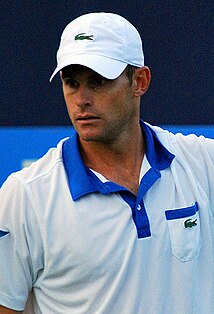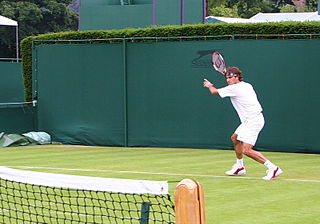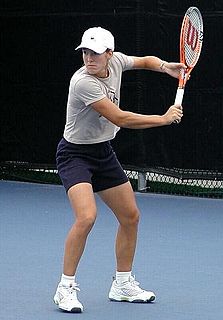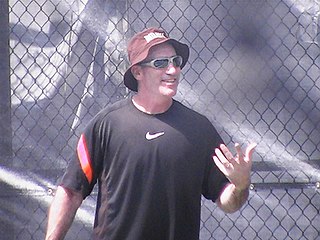
Table tennis, also known as ping-pong and whiff-whaff, is a sport in which two or four players hit a lightweight ball, also known as the ping-pong ball, back and forth across a table using small solid rackets. The game takes place on a hard table divided by a net. Except for the initial serve, the rules are generally as follows: players must allow a ball played toward them to bounce once on their side of the table and must return it so that it bounces on the opposite side at least once. A point is scored when a player fails to return the ball within the rules. Play is fast and demands quick reactions. Spinning the ball alters its trajectory and limits an opponent's options, giving the hitter a great advantage.

Andrew StephenRoddick is an American former world No. 1 tennis player. He is a major champion, having won the 2003 US Open. Roddick reached four other major finals, losing to rival Roger Federer each time.

Robin Bo Carl Söderling is a Swedish former professional tennis player. He reached a career-high Association of Tennis Professionals (ATP) world No. 4 singles ranking on 15 November 2010. His career highlights include reaching two consecutive finals at the French Open in 2009 and 2010, and an ATP World Tour Masters 1000 title at the 2010 Paris Masters. He was the first player to defeat Rafael Nadal at the French Open. Söderling played his last professional match at only age 26 after contracting a lingering bout of mononucleosis.
In tennis, a grip is a way of holding the racquet in order to hit shots during a match. The three most commonly used conventional grips are: the Continental, the Eastern and the Semi-Western. Most players change grips during a match depending on what shot they are hitting.

The forehand in tennis and other racket sports such as table tennis, squash and badminton is a shot made by swinging the racket across one's body with the hand moving palm-first. In tennis, except in the context of the phrase forehand volley, the term refers to a type of groundstroke—a stroke in which the ball has bounced before it is struck. It contrasts with the backhand, the other type of groundstroke. For a right-handed player, the forehand is a stroke that begins on the right side of the body, continues across the body as contact is made with the ball, and ends on the left side of the body. It is considered the easiest shot to master, perhaps because it is the most natural stroke. Beginners and advanced players often have better forehands than any other shots and use it as a weapon.

The backhand is a tennis shot in which one swings the racquet around one's body with the back of the hand preceding the palm. Except in the phrase backhand volley, the term refers to a groundstroke. It contrasts with the other kind of groundstroke, the forehand. The term is also used in other racquet sports, and other areas where a similar motion is employed.

A lob in tennis involves hitting the ball high and deep into the opponent's court. It can be used as an offensive or defensive weapon.
In tennis, there are a variety of types of shots which can be categorized in various ways. The grip you place on will help you have different types of shots, the lower your grip means that the ball is most likely going to be a ground stroke. According to William T. Tilden, "All tennis strokes, should be made with the body' at right angles to the net, with the shoulders lined up parallel to the line of flight of the ball." The serve is the opening shot of a point. Groundstrokes are hit after the ball has already bounced, and can be either forehands or backhands depending on which direction the racket is swung relative to the body. A lob is a groundstroke hit well over the head of an opponent who is positioned at the net. A passing shot is a groundstroke that is hit out of reach of an opponent at the net far to his left or right. A cross-court shot is a shot hit from the left side of one player's court to the left side of the other player's court, so that it crosses the lengthwise centerline of the court. A down-the-line shot is one that is hit more or less parallel to, and near to, one of the sidelines, so that it never crosses the centerline.
This page is a glossary of tennis terminology.
Players use different strategies while playing tennis to enhance their own strengths and exploit their opponent's weaknesses in order to gain the advantage and win more points.

Philipp Eberhard Hermann Kohlschreiber is a German professional tennis player. The right-hander has won eight singles and seven doubles titles on the ATP World Tour and made the quarterfinals at the 2012 Wimbledon Championships. He reached his highest ATP singles ranking of world No. 16 in July 2012.

In ball sports, topspin is a property of a ball that rotates forwards as it is moving. Topspin on a ball propelled through the air imparts a downward force that causes the ball to drop, due to its interaction with the air. Topspin is the opposite of backspin.

Dream Match Tennis is a 2006 tennis simulation game developed by Bimboosoft, a company based in Saitama, Japan. Unlike other games in its genre, Dream Match Tennis was aimed to produce a more realistic depiction of the sport, requiring more skill from the player in order to direct their shots accurately.

In tennis, a pusher is a defensive player who "pushes" back any shot they can chase down, without deliberately hitting a winner. They can angle shots, aim deep, as well as produce effective lobs. Pushers are extremely quick and consistent, rarely making errors. This style of play, similar to a "human backboard", often tires and frustrates more offensive opponents. They will try to win games by eliciting unforced errors from the opponent, i.e. by waiting for them to make the first mistake and losing the point. Pushers love to "dink" balls back with sidespin or backspin, placing their shots at disadvantageous locations for their opponents. The pusher's strategy also tends to involve a fair amount of psychological warfare.

Santiago Giraldo Salazar is a retired Colombian professional tennis player. He played on the ATP tour and represented Colombia in the Davis Cup competition. His best tournament result is reaching the final in the 2014 Barcelona Open Banc Sabadell. He is the highest-ranked tennis singles player in Colombia's history, with a career-high singles ranking of 28th in the world, and 77th in doubles.
The 2009 ATP World Tour Finals (also known as the 2009 Barclays ATP World Tour Finals for sponsorship reasons) was held in London, United Kingdom between 22 November and 29 November 2009. It was the first time the O2 arena hosted the ATP World Tour Year-End Singles and Doubles Championships. The event was renamed from Tennis Masters Cup to ATP World Tour Finals following the rearrangement of the ATP Tour.
The 2010 Sony Ericsson Open, was a tennis tournament for men and women held from March 22 to April 4, 2010. It was the 26th edition of the Miami Masters event and is played on outdoor hard courts at the Tennis Center at Crandon Park in Key Biscayne, Florida, located near Miami. The tournament is a part of 2010 ATP World Tour and 2010 WTA Tour, classified as an ATP World Tour Masters 1000 and a WTA Premier Mandatory event respectively.

A passing shot is a forceful shot, as in tennis or team handball, that travels to one side out of the reach of one's opponent. In tennis, this shot is generally a groundstroke and is used when one's opponent is running to the net or if they are at the net already. The alternative to a passing shot is to lob the ball over the opponent's head. The aim of the passing shot in tennis is to prevent the opponent from returning the ball once he/she is at the net.

A serve in tennis is a shot to start a point. A player will hit the ball with a racquet so it will fall into the diagonally opposite service box without being stopped by the net. Normally players begin a serve by tossing the ball into the air and hitting it. The ball can only touch the net on a return and will be considered good if it falls on the opposite side. If the ball contacts the net on the serve but then proceeds to the proper service box, it is called a let; this is not a legal serve in the major tours although it is also not a fault. Players normally serve overhead; however serving underhand is allowed. The serve is the only shot a player can take their time to set up instead of having to react to an opponent's shot; however, as of 2012, there is a 25-second limit to be allowed between points.













